
Putting Matters |
|
"Good putting is the banishment of doubt.”
--- Ian Woosnam
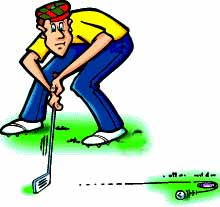
|
We search for the right answer when it is the question that needs to improve. In other words, “What is it going to take to improve my putting?” has a very different energy and feel to it than does, “Wouldn’t it be nice if I started making a few more putts?” By simply changing the emotion underlying the question we change how the answer appears. It really is up to us to adjust the energy of our questions and answers if we want to see improvement in our games.
|
|
To make more putts: |
|
Good putters can putt on any surface because they roll the ball. Good putters make putts on slow greens, fast greens, wet greens, dry greens, bumpy greens, aerified greens, dead greens or an asphalt road if they had too.
I’ve partnered with and played against two players, (one male, one female) that putt good ALL the time.
Both strokes have a hit-upwards look to them. They hit slightly above middle to top of the ball, create an over-spin roll to the ball. Seems like they always make a lot of putts.
From Horton Smith:
“When the ball is sent on its way with topspin or end-over-end roll, it holds its intended line better and actually seems to:.....Hunt the Cup.”
|
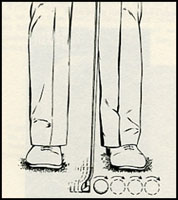
|
|
“When , for any number of reasons, the ball is struck off center, the result is a “wobble,” which can occur in either direction. That “wobble”will prevent the ball from rolling true on it’s intended line of direction, as well as maybe cause it to “spin out” when it hits the edge of the cup”.
|

|

|
Next time when you are on the practice putting green, picture the ball as a miniature Goodyear or Firestone Tire standing upright and your going to hit it with your putter to get it rolling forward.
Don't you want to hit the Middle-to-Top of that Tire to get it rolling?
Don't you want the putter head to be square at contact to the direction that the Tire should roll?
What if that Tire had to roll down a hill, how much pressure would you put on the Tire at contact?
What if it was to roll uphill, how much pressure then?
|
The Ball’s a Tire
Practice hitting the mid-section of ball through impact, then just think what speed you want the Ball / Tire to roll when you are on the golf course next time.
It could be “your” little secret.
|
Return to top of Putting Matters |
Steve Stricker putting tip |
The Stricker Way
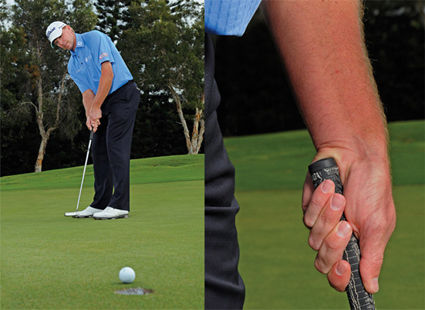
|
The Grip
"I like to grip the putter fairly tight in my left hand, probably a 7 on a scale of 1 to 10, but my right-hand grip is considerably lighter.
I'm a left-hand dominant putter, and the two grip pressures reinforce the feeling that my left side will be controlling the stroke.
I also don't want the feeling of the face twisting, even the slightest, when I strike the ball. I grip the putter in the palm of my left hand, not the fingers. It's resting on my lifeline. This gives me a feeling of unity between the putter's shaft and my left arm."
|
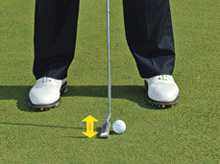
|
The Waggle
"You read that right. I actually "waggle" my putter by bouncing it against the turf a little before I make a stroke. As a kid, I used to forward press the shaft before hitting a putt to reduce tension. But because I want to keep the shaft in the same position from start to finish to improve my consistency, I've developed this bouncy move.
It's hard to go from a static position into a fluid stroke, so this is what I do to make it smoother. Also, my putter sits with the heel slightly off the ground, which results in a straighter back and through motion."
|
"Sometimes I practice rolling the ball with just my left arm. It's been my style from day one."
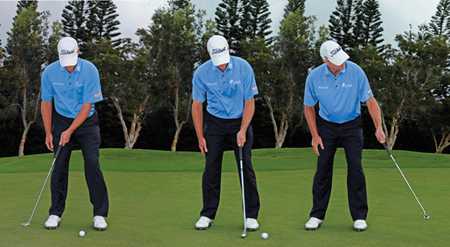
|
The Stroke
"At address my left wrist is cupped, and my goal is to maintain that angle throughout the stroke. Most people have the shaft leaning toward the target, but the cupped wrist sets the shaft in a more vertical position. I believe this helps me strike the ball consistently in the same place on the putter's face as well as put the best possible roll on the ball."
"As I said earlier, I'm a left-hand-dominant putter. I feel as if my pendulum stroke is moved by my left shoulder, arm and hand working together."
|

|
More Thoughts
"I don't worry about speed. I just pick my line and then really concentrate on hitting the ball on that line."
"My ball position is pretty standard, somewhere between one and two inches off my left foot. The ball rolls best from this spot."
"My stroke is pretty straight-to-straight. I think it's got to come inside the target line a little bit, but I don't worry about that."
"The hardest putt is a short, downhill curler. All you can do is pick a line and tap it."
|
I found the comment about not worrying about speed and just think line, was interesting. Some feel strongly the other way around. To each their own because if it helps to make putts....isn't that just WONDERFUL!
--B.Silver
Return to top of Putting Matters
|
Putting Styles |
.... Finding a Way To Make Putts
|
|
To putt well, one must see and feel the proper speed of the ball roll so that the path (line on ground) can be found as visualized. It’s of course invisible, clearly a mental aspect.
But, Before you can get aspects right mentally, you have to get right mechanically. Try and keep it simple (it's not difficult) and understand there is no One and Only Way to make putts.
In fact, if you consider yourself a really good putter, my advice would be to not try and fix something that “ain’t” broken. Just keep doing what you do.
Improve/upgrade your reads and/or how you see the line.
For the rest of us that need help, adjustments can make a difference.
|
|
One of the biggest reasons for missing putts is fear, and fear is always present and will take over completely when there is something unknown. Fear might be a tad of a strong word to use here; after all we are just playing a game. But we all try really hard at times when playing a game, especially this one.
Fear of failure is going to happen when looking at that putt to win the match, all the money or beat the best score you have ever had. Fear of the unknown can lead to indecision and doubt, all killers of good putting.
Therefore, if fear makes us miss putts and fear stems from the unknown, let’s do away with any mechanical mystery by finding some simple mechanics.
|
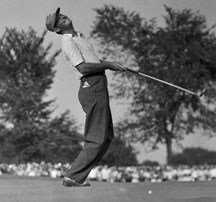
|
|
Here is a description of "a" method that has been around a while. Again, not the only way, but a way.
If you will stick out your left hand with the thumb on top, you will find the hand will work only two ways from the wrist joint. It will bend from side to side and it will also work up and down, but it will not, rotate. Any rotation must come from the elbow joint or shoulder joint.
That is why you generally don’t see good putters with their hands downwards. They are arched upwards and on their more vertical “putter” swing plane. Senior Tour player Isao Aoki was an exception and a great putter.
|
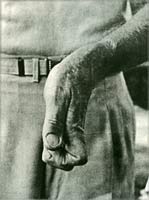
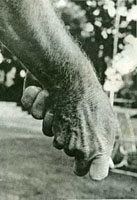
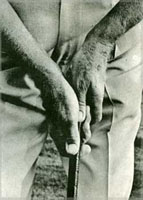
|
|
Take your putter in your left hand (right for southpaws) and just swing it back and forth with this “target” hand as if your were putting with only your left hand (“target side”).
Notice that it swings back and forth easily, but if you want to twist it, you have to do that from movement of your elbow or shoulder. No, the club head is not swinging in a straight line, the SHAFT would be tracing a straight, invisible, mental ground line (blue line) towards the direction in which the ball should roll. I would say the wrists are arching vertically all the time.
The putter head is not swinging in a straight line and it won’t as long as you are not twisting your left arm and don’t start trying to make it swing in a line straight through a imagined dotted line to the hole. All the twisting and turning is why one day you can putt and the next you can’t hole it in a lake.
In other words, the fewer false motions we have the more consistent we will become.
If you see your line by standing closer to the ball, your stroke will not have as much an arc "look" to it. Further away from the ball, the stroke will have a "look" of more arc. Whatever it takes to roll the ball on a path that YOU SEE is the key.
|
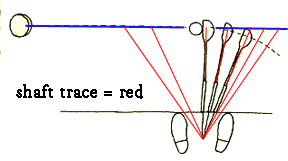
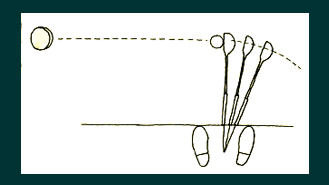
|
|
The putter face (right) is not opening or closing, but is merely swinging back and forth in a natural arc which will hit the ball with good pressure every time. And once you get to hitting that ball with the same solid “pressure” every time, you are on your way toward becoming one of those players that can putt, and look so easy doing so.
The Club’s head may appear like it is opening and closing because you are standing to side of the Target Line on whatever your putter’s plane(angle) is. When the SHAFT traces a straight Line, it is On-Plane. Not over the Line,..tracing the Line.
|
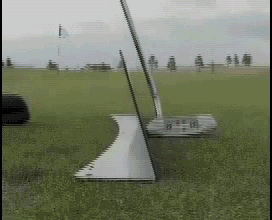
|
|
Ok, so we have some control of the clubface via the Left wrist-target arm direction/motion as described above. Now we have to understand/determine a power source, and I use that word “power” very loosely. I could use “energy point” or “trigger”, for today we will use the words “power source”.
Remember we are talking about basic mechanics regardless of the terminology.
Where is the trigger of your stroke? We all know where that trigger is on a rifle-gun is and how use it. When putting, understanding the power source/style you use can often determine how you start and finish the stroke.
Here are some of the more common ways, or styles. Doesn’t mean they are the only ways, just three of the BEST.
|
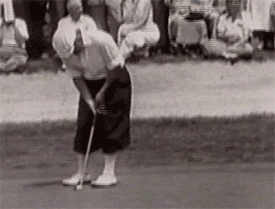
--Bobby Locke
|
Hand(s) Stroke
A real “wristy” style. Could use either or both hands as P-source.
Bobby Locke looks like a “hands” putter and he used a lot of body motion as well.
He was/is considered one of the best putters ever. He was from an era where the greens were not perfect all the time, thus they needed to do a lot more adjusting to different greens conditions.
|
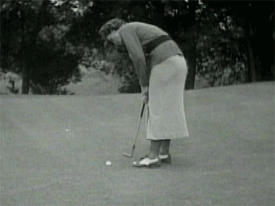
--Babe Zaharias
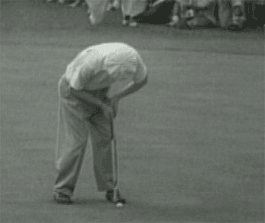
--Byron Nelson
|
Arm(s) Stroke
Both Byron Nelson and Babe Zaharias look like “Arm” putters, which mean they use more arms than shoulders.
A true arm putter will keep the shoulders very passive-quiet during their strokes. Could use mostly Left arm or Right arm. Could use forearm(s) either left or right. The hands-wrist are kind of frozen in place as arms do the work. Hands telling arms what to do, but not moving by themselves.
This is a very natural way of making a putting stroke. Also good for all green conditions.
|
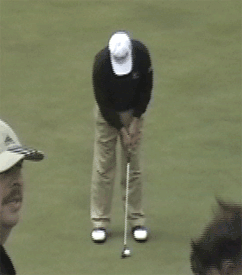
--David Toms
|
Shoulder Stroke
David Toms is clearly a shoulder style. Popular on today’s Tour because the greens are almost always in perfect condition. Just a true Pendulum stroke with Shoulders moving arms and hands within the triangle that forms the arms and shoulders.
There are “Tour” players that would probably say they use a combination of styles, which is their own individual way and feel, which work for them. They are NOT on Tour unless that happens.
|
|
I might suggest however, that most of us would be much better off finding A style and taking ownership of it. Understanding your power source, goes along with finding (or understanding) your style. Once those elements are fairly ingrained, you can go from mechanics to concentrating on just achieving the correct SPEEDS and LINES, which is the real trick (feel) to making more putts.
|
Return to top of Putting Matters |
Horton Smith's Psychology of Putting |
Horton Smith
Horton Smith was a Master of putting. This opinion was shared by Bobby Jones and Walter Hagen. His winning career spanned three decades and was highlighted by winning two Master Championships and three U.S. Opens. Horton Smith was elected to the "Hall of Fame" in 1958, and served as President and Honorary President of the P.G.A. His accomplishments place him among the top players to ever play the game of golf.
Byron Nelson rated Smith the finest putter and chipper of his era, and long after he won his final tournament in 1941, Smith was much sought after by other players for putting advice.
Many players of TODAY are using the fundamentals developed by Horton Smith.
|
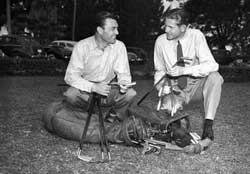
--Ben Hogan and Horton Smith
|
His greatest fame will always come from being the first winner of the Masters, then known as the Augusta National Invitational. In the fourth round, Craig Wood posted 285 early, so Smith knew he needed a 72 or better. After making a 20-foot birdie putt on the 17th hole, he knocked in a four-foot downhiller on the final green to win.
note: In those days the front nine was the now back nine. I can tell you from the experience of standing on the 9th green at Augusta National, it is one of the most extremely slanted greens, (along with Olympic Club’s #18), that I have ever stood on.
--- b.silver
Psychology of Putting
I PUTT BEST when “my hands feel thin.”
This is an old expression and is the only one which, to my mind, clearly expresses the feeling I have in advance of a good round of putting. I never know whether I am going to hole a great many putts, because there are too many outside factors involved for me to be certain of that. All I know is that I seem to have a sensitivity in my fingertips that makes the putter fell like a magic wand over which I have complete control.
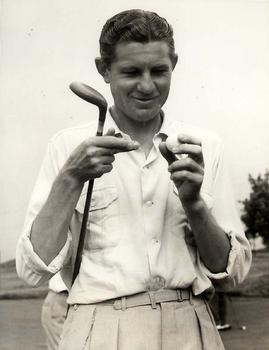
There is a great deal to be said for adequate physical and mental preparation in any sport, but it is particularly vital in as “temperamental” a sport as golf. Sometimes I wonder what might have happened to the evolution of the game if back in the early days of golf those avid Scotsmen had not insisted upon absolute silence when they swung their “shinney sticks.” Perhaps if the roars of the crowd on the baseball diamond or the gridiron were allowed today on the tournament trail of golf the cases of “nerves” might not be so pronounced.
The anticipation that “I will play well today” starts with a leisurely arising in the morning and a comfortably slow and easy dressing for the day. Just as I try to prepare myself for the “paced” or unhurried approach to my game, so should you do the same.
How often I see the busy Saturday-afternoon throng of businessmen rush into the parking lots with their cars, toss their clubs to a caddie, and hurry up the stairs to the locker room with perhaps a yell toward the first tee, “Tell Joe I’ll be right down and to wait for me.”
I try to avoid anything which will upset my equilibrium before the game. If I think my mail might bring bad news, I postpone opening it until later. The amateur golfer should be as careful to get the maximum enjoyment from a game of golf as the most hardened professional golfer. If you are going to play golf at 1:00 P.M. on a busy Saturday, you should realize that you will have to allow a certain amount of time to get to the course, to dress, to practice a little, perhaps to eat a light lunch, and to be ready to play a comfortable game. Even if you are a “once-a-weeker,” with some intelligent planning you can increase your enjoyment of your golf game. One of the best ways of increasing your enjoyment is to cut down the number of your strokes. And one of the vest ways to accomplish this is to allow enough time for some leisurely practice on the putting green before you begin to play.
Quite often the practice green which is available before your “big round” is of a different type of grass, often even cut at a different height than the greens you will encounter out on the course. So, instead of plunking down a ball on the putting green and immediately making a try for a hole 25 feet away, be smart! Realize that the most important thing you can do is to start building up your confidence in your putting ability in general and putting stroke in particular. So start about 18 inches away from the hole in the most level putting area you can find and take four balls and put them down around that cup in a circle. Knock each one of them in with the firmest stroke you can muster. Your confidence will start to grow immediately. Pay particular attention to keeping your grip relaxed and to hitting the ball above center so as to give it the end-over-end roll, which is so desirable. You might even take just one ball and, after placing it with the name on its “equator,” check to see whether or not it is rolling without a wobble.
After you have holed a number of straight, level, short putts, I suggest that you try to find a practice hole with a left-to-right slope. Then, of course, after you have knocked a few left-to-right putts into the hole, putt from the opposite side of the cup in a position which will require the same amount of “borrow,” (amount of break) and knock in a few right-to-left putts. Don’t be surprised or upset at missing a few of these. You will at first. The important thing is to end your practice with a holed putt—perhaps even two or three in a row. Don’t ever end your practice on a missed putt, even if you find it necessary to get closer to the hole.
You should only practice longer putts, however, after you have holed a number of short putts. When you do, work from known distances, so that you can be registering in your mind the strength it is taking to hit the distance you see. Watch to see that your backswing is free and easy, that your hands and arm muscles are relaxed, and that the blade of your putter stays “square.”
It is entirely possible that in the past you have never carried out such an intensive, yet intelligent, practice putting session before a round of golf. I would like to assure you that if you will try such a method of practicing, your enjoyment and appreciation of the game of golf, not to mention the “game within the game.” Putting will be enhanced immeasurably. Such a practice procedure need not last more than ten minutes in order to pay off in a grooved stroke that may save you from one to five strokes on our round. And the confidence that you gain from knowing that even if you “spray” a few shots you can probably recover and sink a putt or two will help our long game. You will not need to try so hard to “thread the needle” to the pin and be so close you can’t afford to miss. Even the 10-footers for pars, while never actually enjoyable, are much less fearsome when your putting stroke is sound and you know it.
A moment ago I spoke about my never knowing whether I’m going to hole a great many putts in an upcoming round even when I know I’m putting well. At this point, with respect to the psychology of putting, I should like to call your attention to the odds on holing a particular putt. I see so many golfers, especially high handicappers, get violently upset at missing, say, a 10-foot putt or even a 3-foot putt. Now I must admit that there is greater reason to become angry at missing the shorter putt, but I feel that very few golfers, even low handicappers, have ever carefully considered the odds on making putts of various lengths.
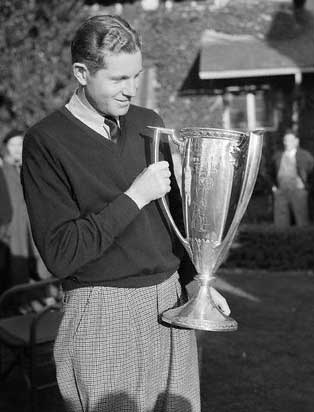
In practice sessions of my own, I have holed as many as twenty to twenty-five 10-foot or 12-foot putts in a row and immediately followed them with four or five straight clean misses at the same distance and from exactly the some spot. However, I try not to let these misses disturb me. By practicing from a constant distance, 10 feet for example, on a practice green, I get to know about how many out of ten I should hole. Perhaps one day I’ll hole twelve out of twenty, on another day ten out of twenty, and on another eight. Some days, I can even run it up to an average of fifteen.
Then I switch to a 20-foot distance and try the same thing in order to see how many out of ten I can hole. I use no more than four or five balls because one will often block the path to the cup and interfere with the next putt. Of course, I get a great deal of exercise, good for the waistline, leaning over to pick the balls out of the cup. Again, in my mind, my “computer” is figuring the averages as well as noting the distance and taking into account the smoothness of my stroke, while it is saying “you can make about five or six, or even seven out of twenty 20-footers, can’t you?”
Thus, when I am out on the course and am faced with a 20-footer on my very first green, the first thought that crosses my mind is that my chances of making this putt are about 1 in 3 to 1 in 4. So when I don’t hole it (I hope I came close!), I say to myself, “Well, don’t be upset at missing that one. You stroked it well, but the odds that you would make it were low anyway.”
Remember, too, that the various imperfections in the green itself, sometimes completely undetectable in advance, tend to decrease the odds of your making a particular putt. On the practice green you have been putting on the smoothest possible track you could find. The regular green might be spike-marked from the all-day tramping of not-too-gentle golf shoes. This is why the early starters on the golf course very often have a great advantage over the late starters and why, quite often, a good score posted early in the last day of a big tournament will withstand all attempts to match it. Late in the day, when the greens have hardened from the heat of the sun and have been scuffed up by many spikes, your chances of holing your usual quota have decreased.
Many times I have found myself, during late rounds, approaching greens that are hard, bumpy, and pocked with divots and spike marks, with a mental attitude acquired from putting on fresh greens that “track right.” Then, if I miss the kind of putt I have been making previously, I get discouraged. A subtle change in attitude occurs, and instead of knowing I’ll make the putt, I start hoping I won’t miss it. This change in attitude is both common and foolish. One has to adjust one’s expectations to the conditions and be aware of the odds.
It might be interesting to tell you my own experience in winning the Masters Tournament in 1934. Craig Wood had gotten an early start, had posted a score of 285. So, early in my round, when I was on the fourth hole, I knew that I needed a par 72 to win by 1 stroke, that is, provided no one else managed to come up with a sensational last round to better Wood’s score. At the seventeenth tee I needed one birdie in the last two holes. Fortunately my third shot on the seventeenth was a short pitch. I hit it to within 12 feet of the hole on a beautifully level spot on the green and quite confidently stroked the ball in for the birdie I so badly needed.
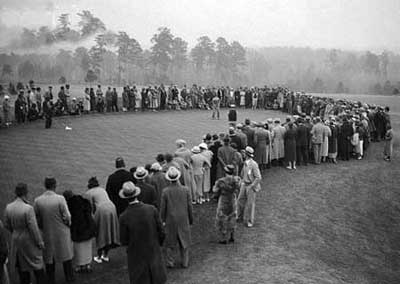
The Augusta National course at that time was played with its present nines reversed, so the eighteenth hole that I needed only to play in par was the present ninth hole, a short 4-par. The hole wasn’t presenting too much difficulty, but the wind was blowing hard and the greens were very hard, almost “swept out” by the wind. There was a trap guarding the short left side of the hole, and in trying to play it safe for my 4, I got well over the trap and found my ball about 35 feet above and beyond the cup, with a slick downhill left-to-right putt coming up. Although I knew very well that I should get “up” to the cup so as to leave myself a short right-to-left second putt ---a much easier one to hole under the circumstances---I felt that I could borrow quite a bit from the left hill and “drift” the ball down close for an easy second putt. I was both surprised and disappointed in myself when I borrowed too much. The ball stopped above the cup from 3 to 3 ½ feet away, leaving me a fast downhill putt with a quick left-to-right break---dreaded by even the most skillful putter.
I studied the putt, and at that moment I had one of those “positive” thoughts: Since the green was slippery and the break was fast, all I could do was hit the ball firmly and squarely. I was also aware that even if I didn’t hole the putt, I could tie for the title and have at least an even chance to win in a play-off. So I stepped up and knocked the ball right in, to win.
Afterwards, a number of people came up to me and said, “You certainly were confident of that last putt on eighteen, weren’t you?” Although I didn’t admit it then, I’ll say now that it was one of the “longest” putts I ever holed, and I am certain that it was due to my attitude and nothing else. It was the positive thought that paid off.
Return to top of Putting Matters |
My Take of 2009 PGA Championship |

Ground Game Principles
T o me the real story of the 91st PGA Championship, played at Hazeltine National Golf Club, was witnessing the greatest player of our time, probably of all time; get as frustrated as you could possibly imagine Tiger Woods looking.
|
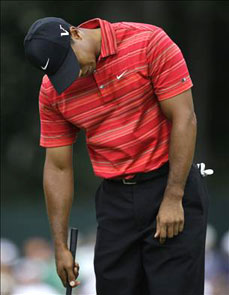
|
How many times have we seen a picture like this one below?
Not too?
|
|
Yes, Y.E.Yang, (ranked 110 in the world) played very well that last day to steal the much coveted major championship from Tiger. But what this day did expose, in my opinion, is what this game often really boils down to; the art of Putting, creating the correct ball speed, reading the lines, making putts, always rolling the ball near the hole.
“There is no similarity between golf and putting; they are two different games one played in the air, and the other on the ground.”
--- Ben Hogan
|
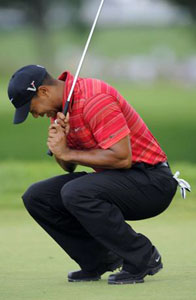
|
Along with that rather blunt “Hoganist” quote, I’ve often heard the old golf saying “the game of golf is 90% mental.” Well, if that were really the case, when swinging, a right-handed golfer should be able to pick up a left-handed golf club and hit it, or vise visa. So I would tend to disagree with that old golf adage.
When Putting on the other hand, those percentages might be fairly accurate; I might even add a few percentage points to the 90% benchmark.
|
|
Tiger said afterwards that he felt he was hitting the ball “real good”. Said his swing felt really good that day. Yet he professed that he made “NO PUTTS”.
Oh we saw him make some putts, but what kept him from winning his third consecutive regular PGA Tour event in a row, plus his 15th major tournament, was his lack of making putts he usually almost always makes.
Jack Nicklaus would seem to always do it. Tiger has always been a great putter, by some, the best on the Tour at that time. (before his mis-hap period)
|
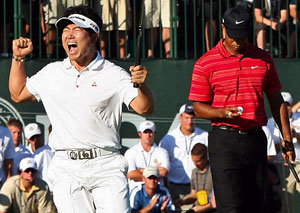
|
|
The lesson that should be learned here is;
(1) of course, nobody makes putts all the time.
(2) you can spend a lot of effort and time learning skills that hit a great 7 iron, or 3 wood on the green, but if you blast or baby the putt to nowhere, you walk away with no reward for all the effort you used hitting the shot.
It happens more times than not while playing golf. But, the better the player you are, the less often it happens. Sometimes hard to swallow, but low scores for anymore usually always means fewer putts, and especially those key putts made at certain times during a good round.
On the lesson tee, a request from many students is: “I need more distance to my shots.” I do understand the desire and needs, but the importance is over-rated.
The short strokes are the great equalizer in golf, especially for those of you that may feel like you don’t make the ball fly far enough. I’ve seen women and juniors make that equalizer work well for them, really well.
Having your short swing fundamentals working will often actually create distance because there becomes less of a desire to try and over-power swings, the killer of circular force in swing motions.
|

|
Now, here is the really good news about the Art of Putting. After some basic fundamentals are learned and understood, and a certain personal skill level achieved, many aspects of putting are much more of a “personal feel” or “your way” of doing it.
|
“There’s no point in discussing putting styles. You grope around, shuffle, bend, re-shuffle, twist and writhe until you find a putting stance that feels comfortable – to you.”
--- Toney Lema
You can develop your own personal way of achieving success on the putting greens in your own golf kingdom. Just remember, it will boil down to between 90 to 95 percent mental. Seeing that mental invisible line while picturing the right speed of the roll.
Success in playing golf usually boils down to how you putt the ball. So give it the attention, and time, it deserves.
According to Earl Woods, that’s how Tiger started to learn how to play.
|
Return to top of Putting Matters |
Minds Eye Training |
TeeDot drill
|
Keeping your head steady/still is a very important fundamental golf, and especially in putting. Some will say it is your eyes that need to be still, not following the ball at impact during that “split” second period when the ball is contacted by the club head. Common sense tells us that in order to keep the eyes still we have to keep the head still, don’t we?
Well not exactly, the head could be very still and the eyes could be very “jumpy”, which is definitely NOT GOOD. There are great putters who appear to move their heads at impact, but the eyes are very “still” during that split second.
The eyes in putting should be like laser beams looking right through the ball. The putter head should be nothing but a BLUR. If you see that putter head open or close, go up or down, “your eyes ain’t looking through the ball, partner”. You must train yourself to keep those eyes looking through the ball when putting until you do it by habit, all the time. By habit means you don’t consciously think about doing, you just do it with the sub-conscious. You train yourself through practice/drills.
Here is an excellent drill for training those laser beam eyes to stay still during your putting stroke.
|
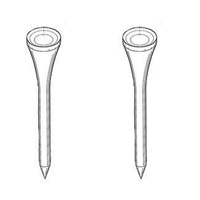
|
1. Get two golf tees, one short, one longer. Preferably white in color.
|

|
2. Get a Sharpie pen, fine point or at least a new sharp pointed end. If the tees are white, get a black Sharpie.
|
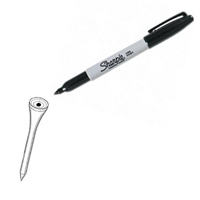
|
3. Using the Sharpie pen, put a dot on one of the tees, right smack in the middle where a ball would sit.
|
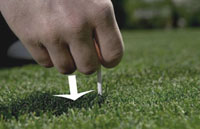
|
4. Now go to a practice putting green. Start with a putt about 2 feet long without too much slope/break to it. Put the tee with the dot on it (2 feet from the cup) into the ground until it is level, flat to the ground. Step on it so that it does not lay above the green’s grass.
note: VERY IMPORTANT!
The other longer tee is used to pry out the shorter dotted tee out of the green when you are done doing this drill. DO NOT LEAVE tee in green. The greenskeeper will kill me, his mowers do not like tees.
|
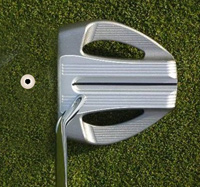
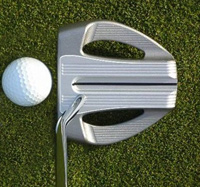
|
6. OK, ready? Make a stroke looking “through” the ball so that your mind is getting ready to look first at the tee then at the dot. The idea here is to have a sub-conscious attempt for your mind to look at tee then dot, THEN THE BALL rolling towards the hole. It must be in that order/sequence for this “drill” to do any good. After practice and repetition, this is what you want to happen as you "visualize" the ball rolling on each and every putt, or…..at least try to each and every time.
|
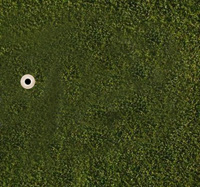
|
This what you should be looking at....and then:
|
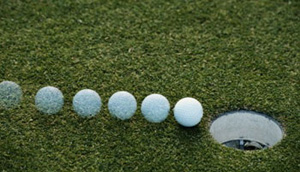
|
THIS, .........and then:
|
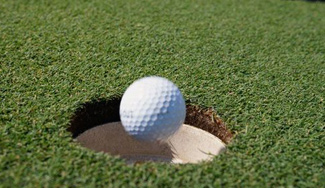
|
THIS
|
Additional comments on TeeDot drill:
- The 2 foot range is a suggested length to start the drill from. You can do it at any length, just don’t get longer until you start to make a lot of 2 footers.
- You should start to “feel” when the stroke is correct or not the minute you strike the ball. The feel is all about the right pressure that is put on ball.
- This drill is a lot about “trusting” your stroke. Hit putts without looking at all where ball is going and if you don’t hear the ball drop in cup, take a guess as to where the ball stopped. Short, long, left or right.
Then look and see how good you are becoming, or how much more practice you need.
That little addition to this drill can really produce another great drill out of this one.
- If you are a pretty good putter and you have just gotten into a “funk” where nothing seems to be falling, just missing here and there. This would be a surprising effective drill for you. You might just be moving your eyes a tad, enough to alter your intended line.
|
Return to top of Putting Matters |
Stockton rules |
|
Dave Stockton is regarded by many as one of the greatest putters alive, both as a player and a coach. Phil Mickelson, among many others, was one of his students. So, as he spoke to the media ahead of the 2021 PGA Championship, Golf.com seized the opportunity to ask for some putting advice.
What they asked him, what are the essential qualities which separate good putters from the rest of us?
The answer that followed was fascinating and actually quite simple.
|
|
|
1) STOP TRYING SO HARD
Stockton explained that at the heart of the problem is golfers simply trying too hard.
“I’m going to tell you it’s simple but a lot of people don’t believe that.”
Putting requires the same amount of thought as signing your signature, he said. If you start thinking too much, you’ll start freezing up.
“If you were going to have a lesson from me, the first thing I would have you do is sign your signature. It’ll take you three or four seconds and you’ll do it. Right below it I want you to take 20 and I want you to duplicate your first signature exactly. You will not be able to do the first letter in your name. And the reason why, if it’s something that should be in your subconscious and you are trying really hard to get this exactly right.”
That pursuit of perfection, Stockton said, is well-intentioned, but ultimately damaging.
“That’s why you can’t putt … the typical putter is putting with the left side of his brain instead of his creative right side.
Putting is feel.”
|
|
|
2) JUST STEP UP AND ROLL IT
It’s really that simple. Stockton then compared putting to a game like darts.
“How many things can you think about if you’re throwing a dart at a dart board? I don’t think very many. [Putting] is like throwing a dart. That hole is our bull’s-eye, and the ball is here. All it’s going to do is go in there.
“It doesn’t help you to try. The first word I’d tell you if you’re putting, don’t try. You want to putt with feel.”
|
|
|
3) TAKE FEWER PRACTICE STROKES
As part of Stockton’s simplify-everything advice, he tells golfers to take a cue (pun intended) from another game similar to putting: billiards.
Stockton explained that when you’re shooting pool or playing billiards, you don’t step up next to the ball and start making practice motions. You step up directly to the ball, stay in motion to avoid tension, and hit the ball.
Practice swings can be helpful, but too many of them can cause you to overthink and tense-up. The goal is to get your feel, but more importantly, to avoid tension.
“So many typical putters have four or five practice strokes … when you’re shooting billiards, you putt the stick behind it and move it back and forth. I’ve been taught to never let the putter basically sit still. I put it in front of the ball, bring it over the ball, one last look at the hole and I let it go. It’s amazing, it goes in all the time.”
|
|
|
4) PICK A SPOT AN INCH IN FRONT OF THE BALL
And finally, if you’re looking for one lasting thought, pick a spot an inch in front of the golf ball — literally one inch — and feel like you’re pushing the ball through that spot.
“I was taught by my dad to putt an inch ahead of the ball, pick a spot, and the back of my left hand which I’m not going to break down, it’s going to go right through. All it has to do is go an inch. He wanted me to give him one inch with no recoil and no coming up. .
Simple, right?
|
|
Return to top of Putting Matters |
|


